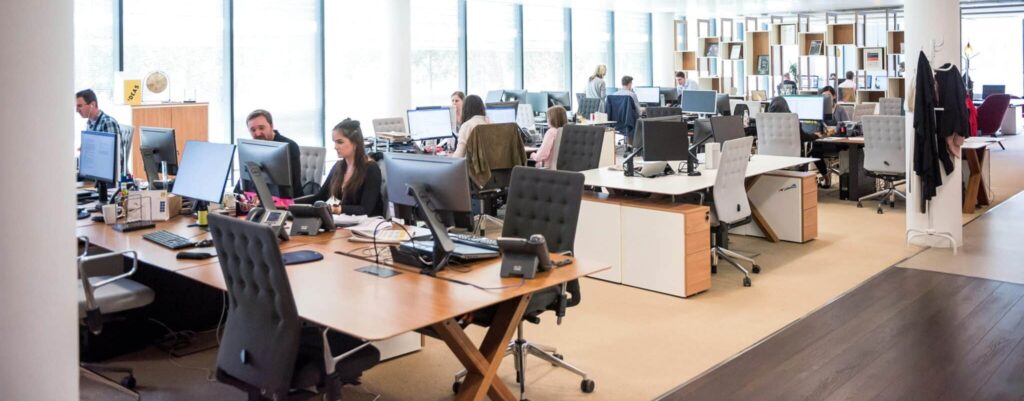Collaborative culture in the workplace: how to create a better office

A collaborative culture in the workplace is better for everyone, employees and leadership alike.
Meanwhile, hybrid and distributed work are quickly becoming the norm. Companies will need to adopt deliberate strategies to create a culture of collaboration in these types of work environments. This is particularly true when it comes to what space types they provide and optimize.
In this article, we explore how (and why) to build a physical office that can better support a collaborative culture in the workplace.
What is the definition of a collaborative work culture?
A collaborative work culture is one that actively promotes teamwork. Everyone on the team is supported and encouraged to share ideas and expertise. And, to pool efforts and resources—all to meet a shared, common goal.
This high level of collaboration usually translates to an employee centric culture. This is where all team members are highly valued, and where their workplace experience matters.
And it usually translates into at least some in-person collaboration. Even if that’s just meeting after work for drinks (common since 49% of employees socialize with their colleagues outside the office).
People intuitively understand the value of cooperation. And any executive worth their salt should be able to espouse the benefits of collaboration in the workplace.
But there’s a difference between paying lip service to a collaborative company culture, versus actually doing the work to foster teamwork and knowledge sharing. Especially in a hybrid office. According to HBR research, when teams are working virtually, cooperation will decline unless active steps are taken to create this culture of collaboration.
Creating a collaborative environment in this context therefore requires trust, open communication, and—crucially—the right collaboration spaces.

What are the characteristics of a culture of collaboration?
In any hybrid work model, a culture of collaboration is one where employee engagement and cooperation stays high. Not in spite of remote/hybrid working, but because of it.
This means creating a workplace strategy that fosters effective collaboration and workflows. And this must be done in the right places and at the right time.
Despite the many benefits of working remotely, we know from recent studies that idea-generation and brainstorming is best accomplished face-to-face.
At the same time, we also know that employees can be just as productive (if not more so) when working from home.
Some types of activities are better done in person. But Gartner research highlights how asynchronous work is just as critical for team innovation as synchronous work.
And given employee preferences, it’s clear that offering some amount of remote work is crucial for attracting and retaining top talent.
So the defining characteristic of a collaborative workplace culture in the hybrid context is one that brings forth different collaborative behaviors in different places.
Specifically, this means:
- Maximizing in-person collaboration for the days when hybrid employees are in-office (and perhaps determining how to entice them into the office in the first place)
- Providing effective hybrid workplace technology, communication tools, and project management on a daily basis (noting that a solid digital workspace is especially vital when working remotely)
In other words, heads-down work can be done (virtually) everywhere. As long as employees are supported with the right tools and apps… As well as instructions and policies on how to use them.
And if the physical hybrid workplace provides a wide variety of ample and well-planned collaborative workspaces, then companies can expect more and better collaboration from everyone, all of the time.

How do you build a collaborative culture in the workplace?
Companies that promote collaboration are five times more likely to be high-performing than their less collaborative counterparts. So it’s no surprise that smart companies are actively looking for ways to do so.
But there’s one essential element for building collaborative culture that may be overlooked: simply put, physical space matters.
Along with the rise in hybrid working, the demand for meeting rooms in flexible spaces rose 73% from 2020. To keep pace, companies are exploring new ways to create new types of collaborative spaces. Often moving away from the stuffy conference rooms of yore.
“As much as you can, take the space you have today and create those additional spaces that people need,” says Susan Wasmund, Senior Managing Director of Occupancy Management at CBRE, in a recent discussion on workspace planning. “With minimal investment, companies can create more collaboration spaces in the spaces they [already] have, and potentially transform one-to-one stations or offices into huddle rooms, conference rooms, or mobile offices that anyone can use.”
Use real-time data to support team collaboration
The drive for what Wasmund calls ‘me’ to ‘we’ spaces is not simply about throwing up some new meeting rooms and calling it a day.
Instead, many companies are embracing a variety of new approaches to boost collaboration in the office. Like activity-based working, agile working, working neighborhoods, flex spaces, and better meeting room design. This is often part of a larger effort to create a more flexible work environment. One that better supports collaboration and other business goals.
Of course, budgets are tight, and ROI is always the top concern with any workplace changes.
Before adopting any changes, space planners and team leaders therefore need actionable workplace data analytics to ‘get it right.’
Specifically, they’ll need insight into how the workplace is being used, by whom, on which days, and for how long. This includes insight into the real estate portfolio as a whole. As well as more granular real-time insight into how employees are interacting with different types of workspaces day-to-day.
Armed with this presence-based utilization data, they can see which spaces perform the best—and create more of them.
Break down data silos
Every data source comes with its own limitations. To create a more accurate and useful picture of office use, facility managers (FMs) and space planners will therefore need to break down data silos and combine multiple data sources.
For example, while employee surveys are incredibly useful for understanding behavior, people are notoriously bad at predicting their own actions. Meanwhile, room and/or desk booking data alone only provides one window into true office use. Relying solely on either can lead to gaps in understanding.
You can only gain accurate presence data—i.e.: the data that illustrates the true utilization of the office—by combining data from multiple sources.
According to CBRE research, 90% of organizations collect and use this type of utilization data today. A significant jump from just 11% in 2021!
Sources for building this presence data can include wifi logs, employee badge swipe data, and occupancy sensors.
This data can then be combined with room and desk reservations. This is in addition to employee self reporting and surveys (critical to get at the why of office use). And also in addition to manual office censuses (i.e.: FMs ‘walking the floor’).
“There’s a huge shift away from using more static data points and metrics, to measuring reality,” says Wasmund.
Creating this more accurate understanding of true office space utilization can be the key to building the right types of spaces to support collaboration strategies in the workplace.
It can also provide key insights into how to improve workplace utilization to support a variety of other stakeholder interests and business outcomes. Especially important as companies seek to overcome any hybrid challenges to teamwork.
Test and iterate your ways into better collaborative spaces
Different companies—and sometimes even different departments or teams within companies—will have different collaborative processes that require different types of collaboration spaces. Figuring out what spaces will best support teamwork requires a ‘test and learn’ approach.
When companies are collecting the right workplace data, they can start to test new configurations almost right away. This is an opportunity to gather internal data to develop new goals and benchmarks. It can ultimately lead to a unique hybrid approach that boosts both their culture and their productivity.
“Think about this intentionally for your business needs,” suggests Maya Ketter, OfficeSpace VP of Client Success. “What we have seen most successful organizations do is set a baseline that works for them internally.”
When space planners and FMs have the right data at their fingertips, they can start to quickly implement pilot programs to test out new floor plans and other changes. Ultimately, if you’re able to measure efficiency in the workplace, then you can improve that efficiency, too.
So if the goal is to boost collaboration, companies can set their own internal benchmarks. Then, they can see what changes are working. Has a specific team or department been coming into the office more? Are employees overcrowding some sections in the floor plan, but leaving others empty? Are incentives to encourage office use working? Do rooms with Zoom integration get significantly more use than rooms without it?
Note that this iterative process is the same one companies can use for whatever goals they have in mind.
“Developing new strategies doesn’t have to be a long, daunting implementation process,” says Ketter. “All you need to do is make sure you learn from your experiments and iterate towards your goal, whether that’s collaboration, productivity, the right cost structure, or something else.”
Make the office the destination of choice
Like we’ve covered… One of the main benefits of in-person working is its impact on collaboration and culture in the workplace.
That’s why many hybrid leaders are now anxious to get people into the office, at the same time that they’re wary of implementing strict mandates. So instead of implementing those mandates, many instead are trying to make the office a destination of choice. I.e.: a place employees want to be, at least some of the time.
The following three elements all play a critical role in these efforts.
- First and foremost, coming into the office needs to be a frictionless experience. If it’s hard to book desks, connect with colleagues, or find your way around, then many people simply won’t bother to come in.
Typically, making the office frictionless requires good workplace collaboration tools. Specifically, a visual directory and the ability to book rooms and desks via mobile app and Slack or Teams integrations go a long way here.
- Second, companies should be willing to test out different ways to incentivize office attendance—and, they need to track what’s actually working. Are team-building activities effective? Do more employees come in when there’s free lunch or a bar cart? Or does covering parking and transit passes have a bigger impact?
Once you determine what’s actually working, you can start to focus on providing what matters most to the rest of the team. - Third, make sure to use messaging so that employees know why the company wants to encourage office attendance. Leadership should be upfront about the benefits of in-office attendance for everyone. And, they should also ‘walk the walk,’ by coming in themselves and actively collaborating with employees (although that can’t translate to micro-management).
“Transparency is huge,” says Emily Mullen, Manager of Talent Acquisition in People Operations at OfficeSpace. “Talk with employees and include them as you make decisions for the workplace, instead of just telling them what to do. That improves connection, and it really has a positive impact on culture.”

What are the benefits of a collaboration culture in the workplace?
So far, we’ve covered how to boost collaboration. But why exactly is collaboration important in the workplace?
Collaborative companies enjoy a host of benefits. Employers are happier (reporting up to 17% higher job satisfaction) and more likely to stick around (with turnover rates reduced by 50%). So it’s not surprising that 75% of employees rate workplace collaboration as being ‘very important.’
And looking at the brass tacks, teamwork can increase sales by 27%, and improve innovation in the workplace by 30%.
Connecting fully in-office employees, remote teams, and everyone in between can ultimately lead to a more cohesive workplace, and a more collaborative culture that benefits everyone.
“Tie that transparency and communication into a commitment to engaging with employees in the right way and making spaces that improve employee experience along with the company’s performance,” says Mullen. “That’s what has a big impact on culture.”
OfficeSpace powers a more collaborative culture in the workplace, with intuitive software that supports employees and employers. Book a free demo now.
Photos: vadimguzhva, xavierarnau, Hero Images, jacoblund




